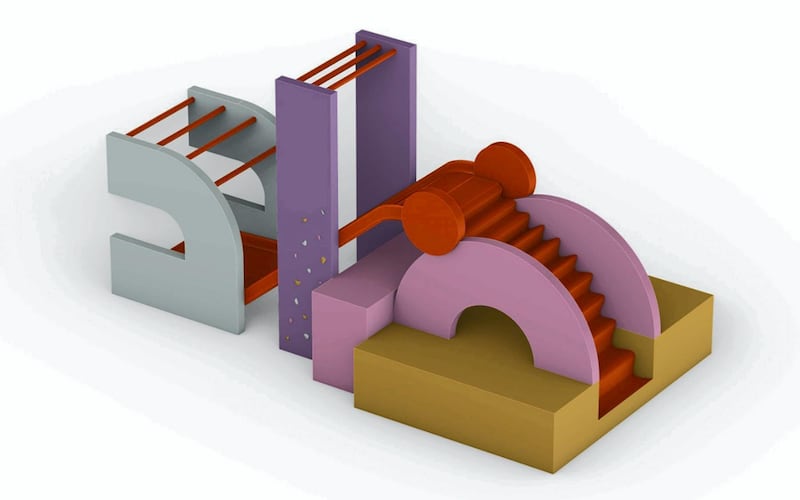The purpose of good design is manifold, and nowhere is this more evident than at Dubai Design Week. The event has long celebrated the creation and advancement of meaningful products, exhibitions and technologies, with a view to giving emerging local, regional and global talent free rein. At this year's show, which starts on Monday, November 11, preservation – of people, products and the planet – seems to be top of mind.
Even as saving the environment comes into sharper focus, so does conserving age-old techniques, which in turn may protect the crafts communities that practise them. Solutions to preserve cultures and values are put forth, while elsewhere, designers come up with ways to firm up concepts of gender and equality, or look to make the most of the cutting-edge technology we now have access to. Spiritual totems sit side by side with gourmet cuisine, even as the future of design is weighed on the scales of sustainability.
Whether it is to fulfill a utilitarian need or an aesthetic desire, above all, good design is – and always has been – about keeping an open mind. Let this overview of Dubai Design Week be your guide.
Abwab
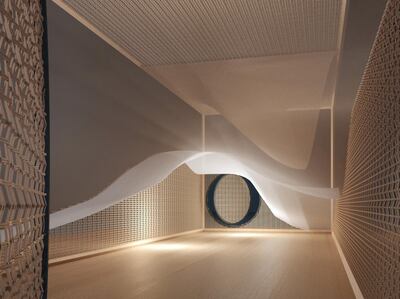
One of the event’s anchor exhibitions, Abwab commissions works from the Mena region and South Asia. Each year’s theme is meant to spotlight talent and stimulate information exchange. “Recreate the classrooms of your culture” was this year’s brief to a trio of design houses from India, the Eastern Provinces of Saudi Arabia and Lebanon, and their interpretations are at once potent and poetic.
The latter – at present riddled by mass protests – explores the concept of a wall, a structure with confining connotations, but also an essential element of architecture. Wal(l)tz, by T Sakhi Architects from Beirut, is replete with paradoxes. Despite its rigid shape, the wall is crafted in recycled foam, to reflect resilience in the face of adversity. The animation is interspersed with cracks to overcome barriers and encourage interaction. Most importantly, perhaps, viewers become performers when interacting with Wal(l)tz, and "find themselves in a choreographed protest".
Contradiction also lies at the heart of the India pavilion. The whole country is the classroom here, with the team from The Busride Design Studio noting "everything that is true of India is equally untrue, every point has its own valid counterpoint". Visitors will be confronted with a cornucopia of motifs: from "epiphany" lamps that use stained glass and wood carving, to a retelling of the myths of our creation that vary from community to community. All of these are scattered within labyrinth-like tessellations, inspired by the opulent Mughal dynasty, yet made from rough-spun khadi fabric.
Meanwhile, Saudi Arabia’s Azaz Architects worked with the craftspeople of Sa’af, a project that safeguards palm-frond weaving, a craft native to the kingdom’s Eastern Provinces. The cocoon-like structure is created from and filled with textiles and weaves, allowing visitors to appreciate the craft at close quarters.
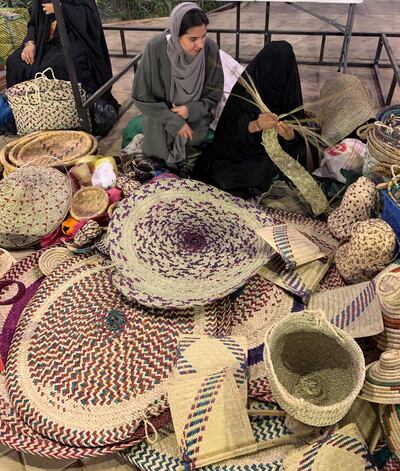
Global Grad Show
This exhibition offers a first look at more than 150 inventions, courtesy of graduates from as many universities around the world, including Harvard University, Imperial College London and University of Sydney. Last week, Dubai Design Week announced a Dh1 million annual fund to support student start-ups focused on creating positive social impact, as part of the Global Grad Show. Designed under themes such as sustainability, gender and equality, wealth and disparity, technology and education, this year’s projects put in mind bright-eyed and visionary young designers, intent on making the world a better, safer and cooler place.
Case in point, a "recipe book" put together by a Central Saint Martins student, of various waste and renewable materials – from biological scraps to invasive plants such as hemp and seaweed – for architects who soon may have no choice but to turn to sustainable, low-cost construction materials.
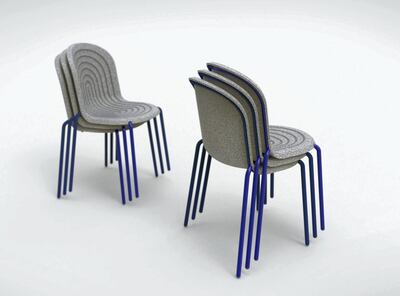
Eco-care is also a priority for a student from Design Academy Eindhoven, who came up with Kas'i Koral, a bucket-like device designed to provide a temporary shelter for fish, which in turn will generate algae, which will encourage coral polyps to grow. Elsewhere, seats are created from e-waste such as insulated wires, office chairs are crafted from bountiful bamboo, while a combination of hemp, casein and lime provides a new material that can be used to make a range of furniture.
Several projects are universal – such as a wearable tracking device for visually impaired swimmers, and a computer mouse that helps to avoid carpal tunnel syndrome – while others are designed for specific societies. Tumar is a communication medium created, says the designer from Poland’s School of Form, “specifically for patriarchal contexts such as [my] home country of Kyrgyzstan, where equality between partners is often lacking”.
Tumar is a box filled with objects that represent spheres of marital life: love, children, career, finances, religion and traditions. Each object comes with cards that address important but often uncomfortable questions. The designer envisions stacking the objects to form a totem representing a couple's priorities, which can then be shifted around as the relationship evolves.
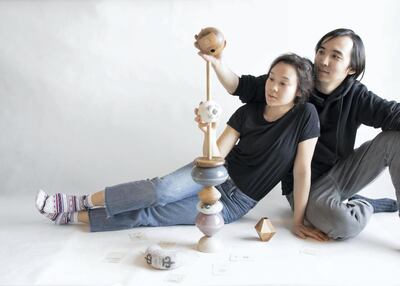
Installations
Totems are also the big draw at the Klove Studio booth, which is displaying its Shamanic Soul collection. The main installation is a life-size gypsy caravan made from brass, and houses pieces inspired by traditionally powerful talismans – from tiger, wolf and monkey heads to eagles, peacocks and various plants. The totems are juxtaposed with dreamcatchers, chandeliers and other lights to enchanting effect.
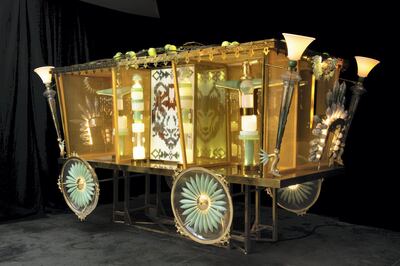
Another installation to look out for is Malaab Dhad by Akwan, a company and social movement that aims to instil "the love of Arabic in children's hearts". The colourful structure is a series of sculptures in the shape of letters from the Arabic script, thus drawing attention to the language in a fun way.
Over at the Downtown Design fair, which is part of Dubai Design Week at D3 from Tuesday, November 12 to Friday, November 15, is a sculpture by Anthony James. The British-American artist from Los Angeles is known for his performative installations that travel the world. This is the first time his Icosahedron will displayed in the Middle East – and it can best be described as a 20-sided cage of steel composed of consecutive equilateral triangles, with a core of psychedelic light or, in a word, hypnotic.
Exhibitions
Amid the dozens of artworks and furniture on display is a rather intriguing exhibition called Design, Delivered, which promises "edible experiences" to all foodies at Dubai Design Week. The show, by Deliveroo, includes an installation created by Hadeel Subahi, founder of Fold Lab in Dubai. The origami designer's edible tree is made of recycled packaging, and visitors can pluck and eat treats from within its foliage. These include cookies, muffins, sushi, salads, sandwiches and juices, provided by Deliveroo partners Br8, Magnolia, Sugarmoo and Sushi Art among others.
"This is an installation that encourages recycling, is interactive and delicious all at the same time," says Subahi. "The food we eat, make, like or aspire to, says so much about who we are. We are all artists when it comes to the way we live, and food is one of our most important means of expression. To be able to combine something as essential and diverse as our daily meals with my passion for reusing materials through art was an amazing opportunity."
The exhibition also has a walk-in oven, which is an entire room set up like the inside of an oven using lighting and temperature control, with the aim to make lovers of steak and pasta “part of the process”.
In stark contrast to Willy Wonka’s chocolate factory-like ambience at Design, Delivered, is Turquoise Mountain’s Kabul exhibition, which will transport you to Murad Khani. The look-feel of the heart of the Old City of Kabul is made realistic through the clever use of immersive multimedia.
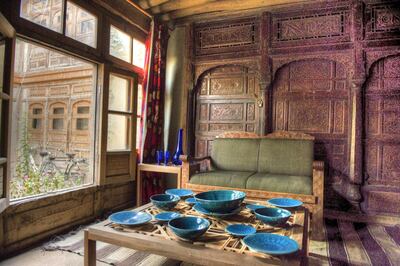
"It can be a surprising perspective for those who associate Afghanistan with challenge and strife … and a unique opportunity to present the little-known richness of Afghan culture by showcasing its traditions and artefacts in an interactive way," says Francesca Recchia, acting director for the Institute of Afghan Arts and Architecture.
Finally, while the bulk of Dubai Design Week activities and installations are at D3, the event also hosts a series of exhibitions and talks at various venues across the city. One such collaboration, Furniture Design for Sustainable Future, between The Workshop Dubai and Zinjaar Vintage, is being held at the former’s Jumeirah space. Its purpose is to bring a collection of antique and vintage furniture – which has a carbon footprint that’s 16 times lower than that of new products – to interested consumers.
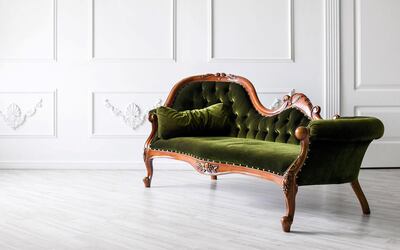
So whether you're looking to buy, browse or simply become more aware of the products and ideas out there, head to Dubai Design Week from Monday, November 11 to Saturday, November 16.
For more information, visit www.dubaidesignweek.ae
